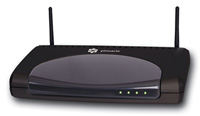Author: Joseph Moran
Review Date: 2/16/2007

Back at the turn of the decade — or millennium, if you like — the digital video recorder (DVR) revolutionized TV watching by letting viewers record shows automatically to watch at their leisure. The capability to “timeshift” programs frees viewers from the vagaries of network scheduling or the hassle of having to fiddle with videotapes. Still, while DVRs let you decide when to watch programs, you still need to be in front of the DVR and TV. Or, at least, you did.
In the last couple of years, however, we’ve had the advent of “placeshifting” devices that let you watch television from a PC in any room in your home — or, for that matter, from outside your home. Sling Media’s Slingbox products are iconic in the category, but they’re not the only game in town — an alternative is the $250 PCTV To Go HD Wireless from Pinnacle Systems.
The PCTV To Go HD differentiates itself from the Slingbox in a number of ways, not the least of which is integrated Wi-Fi (the Slingbox offers only Ethernet). The PCTV To Go also sports a phalanx of AV inputs and outputs that allow you to physically integrate the device into just about any TV or home theater setup. On the other hand, a convoluted and inflexible network configuration can make setting up and using the unit something of a chore that limits your viewing options.
Hardware Setup
The PCTV To Go HD Wireless is a fairly wide device, with about the same footprint as the average (non-DVR) cable box. That’s OK, though, because the longish chassis allows Pinnacle to pack in just about every type of video connection one might care to use. The PCTV To Go gives you a choice of coaxial, composite, S-Video and component video inputs, along with a pair of analog RCA-style jacks for audio. (There are no HDMI or digital audio connectors.)
Better yet, all of the PCTV To Go’s AV ports have inputs and outputs, so you can connect it between devices (e.g., your cable box and your television) instead of hoping that your video source has an unused set of outputs. That’s notable, because most Slingbox products don’t support this kind of pass-through connection (the $249 Slingbox Pro does, but not for component video unless you buy a separate $50 breakout box).
The PCTV To Go’s plethora of ports let me easily connect it to a Toshiba TiVo/DVD recorder combo via component video. (I found out later that PCTV To Go didn’t like the TiVo’s progressive-scan output signal, so I had to set it to interlaced in order to get a clear picture). Another nit to pick is that the PCTV To Go only comes with coax and composite cables, so if you want to use superior-quality S-Video or component video, you have to spring for the cables yourself.
Network Configuration
Considering how simple the physical setup was, I expected a simple process with the PCTV To Go’s network setup wizard. What I encountered was a process that was a bit less straightforward than I’d hoped. You might think that using the PCTV To Go would be a simple matter of joining it to your WLAN and then watching it from any computer on the network, but alas, this isn’t the case. Rather, you must decide in advance how you plan to access the PCTV To Go, and then set the device up accordingly.
For example, if you join the PCTV To Go to your network via Wi-Fi, you can’t reach it from PCs that use wired connections, even though they’re on the same network. In order to use the PCTV To Go with wired clients, you need to set up an additional connection from the device to your network through its 10/100 port. If your home isn’t wired for Ethernet, this relegates you to using a powerline technology like HomePlug (or paradoxically, a Wi-Fi-to-Ethernet bridge). This is no different from what’s required with the Ethernet-only Slingbox devices — but in the case of the PCTV to go, it seems contrary to the idea of buying a placeshifting device with built-in Wi-Fi.
Conversely, if you decide to forgo the built-in wireless and instead use the PCTV To Go’s Ethernet jack as the sole connection to your network, the setup wizard skips over the wireless setup entirely. In this scenario, you’ll be able to access video from wired clients, but not from wireless ones. Even if you try to be clever and take the Ethernet-to-Wi-Fi bridge approach, you still won’t be able to watch from wireless clients, because the player software detects a mismatch between its wireless connection and the ostensibly wired one of the PCTV To Go.
The upshot of all of this is that if you want to be able to access the device from both kinds of clients, you need to set up the PCTV To Go via wireless, then connect a Ethernet cable afterwards. If you use a wired connection first, the only way to set up wireless is to disconnect the network cable, re-run the setup wizard, then re-connect the cable.
The reason for the PCTV To Go’s convoluted network configuration options is that it supports multiple simultaneous clients, and the output differs depending on how you’re connected. For example, wired clients get unicast streams (since each has dedicated bandwidth), but wireless clients instead get a multicast stream to conserve bandwidth on the shared medium. Regardless of the connection type, the PCTV To Go streams MPEG-2 to all local clients, while remote clients get MPEG-4.
Another complaint about the PCTV To Go’s wireless support is that WPA isn’t supported — only WEP. (The setup wizard actually displays WPA encryption as an option, but it’s grayed out.) I continue to be dismayed every time I encounter a wireless device that forces us to use an encryption scheme that can be cracked with the computing power of a Casio wristwatch. Pinnacle says WPA support is planned for late March, and that the wired/wireless limitations will be removed in a future release, but they couldn’t provide a precise timeframe.
Once you get past the irksome network configuration dilemma, you can pick your cable box, satellite receiver or DVR from an extensive list provided, test the video/audio signals and remote control operation, and complete the configuration so you can begin watching your programs.
Player Software
When you fire up Pinnacle’s PCTV To Go Player, you’re presented with a clean and easy-to-use interface. You can easily pause and resume the video, and there’s a button that takes you back to a live, real-time stream. You can also record what you’re watching, which is handy if you want to save something to watch later when you won’t have a connection (like on a plane). The problem is, the record feature only works within the local network — you can’t use it if you’re logged in remotely from your hotel room.
The PCTV To Go’s on-screen “remote” is functional but generic. It offers buttons for most major functions, but some device-specific commands can only be summoned via a lengthy pull-down menu. It does the job once you get used to it, but I much prefer the Slingbox in this regard — it uses the familiar layout of your video source’s actual remote, making device control effortless.
Streaming quality on the PCTV To Go leaves little to complain about, whether you’re accessing it from inside or outside your home. In either case, video and audio quality was quite good. While viewing locally, the image was quite sharp and crisp as the player software reported streaming just shy of 6 Mbps.
What’s That Term? Not sure what a particular term means? Check out the searchable PracticallyNetworked Glossary. |
I also had no trouble logging into the PCTV To Go from a local hotspot (the player can locate your device using a friendly name that you assign during initial setup). Remote streaming performance was a bit more than 300 Kbps, and the stream looked almost as good as it did on the local network — though it periodically got cloudy from time to time as network conditions turned inhospitable.
The Bottom Line
The Pinnacle Systems PCTV To Go HD Wireless offers many things the Slingbox line currently does not — Wi-Fi, standard component and pass-through AV connections, support for multiple clients, and the capability to record video. That said, these features don’t make up for the highly inflexible network configuration and lack of WPA support. When those issues are fixed, the PCTV To Go HD will be a more credible alternative to the Slingbox. In the meantime, if you value the aforementioned features, can temporarily live with WEP, and don’t need access from wired systems, the PCTV To Go is worth a look.
Price: $249.99 (MSRP)
Pros: Component AV inputs with pass-through support; allows multiple simultaneous viewers; player software can record video off local network
Cons: Confusing and inflexible network setup, no WPA support
Review appeared originally on Wi-Fi Planet.com


